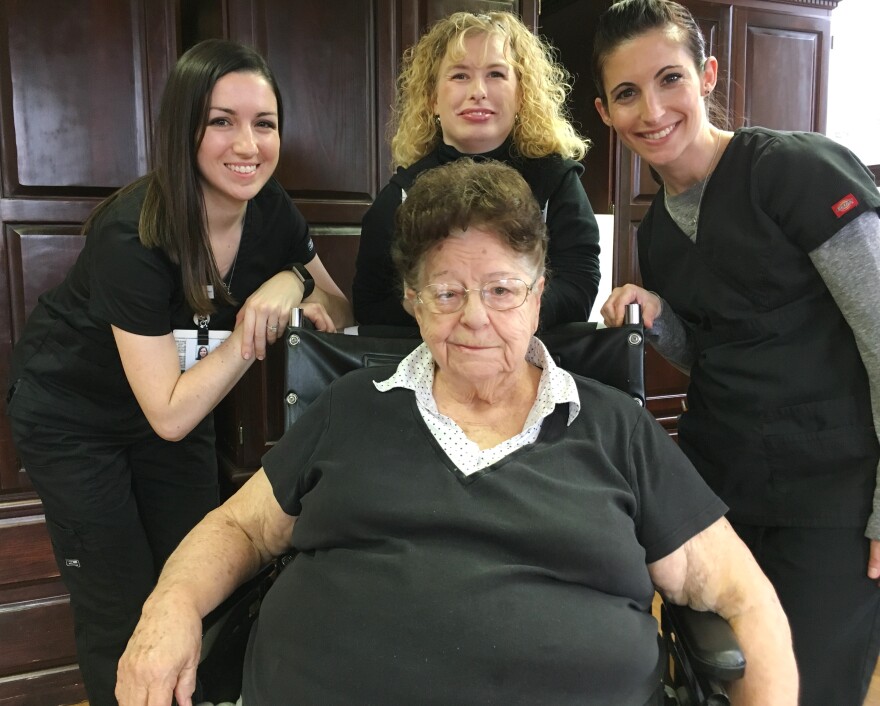Doctors in Cleveland have for the first time implanted electrodes in the brain of a partially paralyzed patient in order to help them regain movement lost to a stroke. It’s the latest example of how researchers are pushing the boundaries of a new field of medicine.
In this week’s Exploradio, WKSU’s Jeff St.Clair looks at the novel uses of deep-brain stimulation.
Anna Franks is a stroke patient at Cleveland Clinic Akron General’s Edwin Shaw Rehab Hospital in Cuyahoga Falls. At 85 she's learning to play corn hole.

It's one of many forms of physical therapy her support team is using to retrain her brain to do old tasks in new ways.
Speech therapist Laurie Ann Bonkoski has a useful analogy for the hard work of stroke recovery.
She says if you imagine your brain as a house, and a big storm comes by and drops a tree across your front door blocking the entrance, “That’s the stroke.”
But Bonkoski says there are other ways to get into that house.
"There’s a back door, windows, a side-door, and those are the other pathways that we’re trying to open up.”
It’s a similar backdoor approach that a team at the Cleveland Clinic is exploring that could someday help people like Anna Franks recover quicker.
Backdoor to the Brain
Dr. Andre Machado is hoping to speed the healing of stroke-damaged tissue by electrically stimulating a part of the brain nowhere near the injury.

The cerebellum sits way in the back of the brain where it coordinates movement in the body. Machado says there’s a direct line from the cerebellum to the distant part of the brain strokes often strike.
The name of the connection is the unnervingly long cerebellothalamocortical pathway.
Machado breaks it down for us as “the pathway between the cerebellum and the cerebral cortex via its relay in the thalamus.”
Machado hopes to take advantage of that pathway’s normal role of coordinating movement by using it to restore mobility in people paralyzed by stroke.
He’s found that sending electrical impulses through the pathway boosts the building of new brain connections, or synapses, in the damaged area. But it doesn’t work by itself.
“What drives the formation of new synapse, in my opinion, is really the training, the physical therapy.”
Machado thinks deep- brain stimulation of the cerebellum provides the added juice to make physical therapy stick.
Clinical trial underway
After a decade’s worth of experimenting on animals, he’s ready to try it in humans as part of a $5 million clinical trial.
In December, Machado inserted a tiny wire electrode into the cerebellum of his first patient. Next month, he’s going to switch it on for the first time.
He’s of two minds on how to react to the historic moment.
“The clinician side of me is very excited that I am bringing a new hope that can help my patients in the future. The scientist side of me has to remain skeptical.”
Even if the procedure doesn’t work entirely as expected, Machado’s not worried it will do any harm.
“To my knowledge we have never seen a negative effect of brain stimulation that was irreversible,” says Machado.
Although this is the first time deep-brain stimulation has been used to treat stroke, Machado has used it to help hundreds of people with Parkinson’s disease.
Prime time brain surgery
Over the past decade, deep-brain stimulation has become so routine, it’s now entertainment.

National Geographic produced a live broadcast of surgeons in Cleveland performing the implantation of electrodes into the brain of Parkinson's patient, hosted by Bryant Gumbel.
University Hospital neurosurgeon Jennifer Sweet was part of the live broadcast.
“We really just wanted to demystify this procedure,” says Sweet.
She says while treating Parkinson’s with deep brain stimulation is prime-time viewing, a slew of other treatments are waiting in the wings.
“Epilepsy has been investigated, major depressive disorder. People are studying the benefit of this for addiction; we know that it can be effective in obsessive compulsive disorder, it’s been used to treat Tourette’s; it may even be an option for anorexia or obesity or hypertension.”
A few years from now, deep-brain stimulation could be an option for stroke patients like Anna Franks at Edwin Shaw, augmenting physical therapy.
But even without it, she says her team gave her hope for recovery, “and these girls have taught me I can do it!”
https://www.youtube.com/watch?v=Bnl28ZM5Kfw









